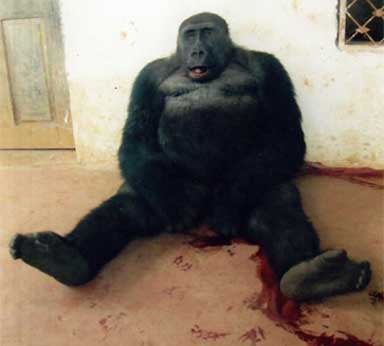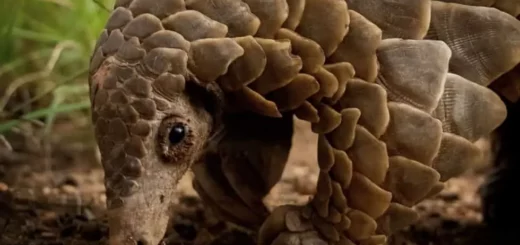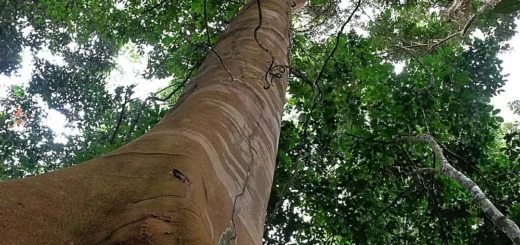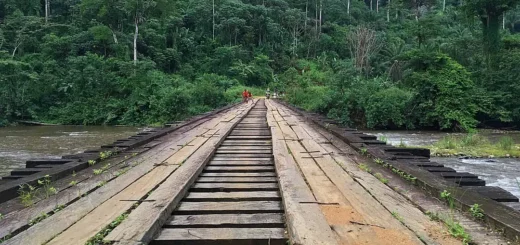
The Highlands’ dense, lush rainforests have been blessed by four flagship species, three of them primates: the Critically Endangered Cross River gorilla (Gorilla gorilla deilhi) of which less than 300 remain in the wild; the Endangered Nigeria-Cameroon chimpanzee (Pan Troglodytes ellioti), the most threatened of chimp subspecies likely numbering fewer than 6,000 individuals; the drill (Mandrillus leucophaeus); as well as the Vulnerable African forest elephant (Loxodonta cyclotis).
Cameroon’s government acknowledges these biological riches, along with the extreme danger they are in, and has sought to protect great apes and other species by conserving forestlands. “These wildlife species are under threat due to poaching, habitat loss and fragmentation through human settlement and conversion to farmland for subsistence,” explained Nono Joseph, the regional chief of wildlife protection for Cameroon’s Ministry of Forestry and Wildlife (MINFOF). However, Joseph admits that the government often lacks the resources needed to fully protect Lebialem Highlands biodiversity.
Which is where and how the Environment and Rural Development Foundation (ERuDeF), a national NGO, fits into the picture.
“Currently, ERuDeF and its partners are assisting the government of Cameroon to create a system of protected areas in the Lebialem Highlands Complex,” said ERuDeF President Louis Nkembi. “The three on-going projects are the Tofala Hill Wildlife Sanctuary, the Mount Bamboutos Integral Ecological Reserve, and the Tofala-Mone Forest Corridor.”

Great apes under pressure
Nono Joseph outlines the suite of problems facing one of these protected areas, the Tofala Hill Wildlife Sanctuary: “The existence of government measures on great ape conservation has not guaranteed effective management of this sanctuary,” he conceded. Its “wildlife species may even become extinct with increased human activities [by the more than] 30 indigenous communities adjacent to the Sanctuary.”
The villagers (farmers, poachers and hunters) are still engaged in logging, mining, agriculture, and the construction of infrastructure, in and around protected areas. The surrounding communities still depend on bushmeat hunting for food and for selling in local and urban markets. In addition, the majority of farmers on the periphery or inside the forest practice slash-and-burn agriculture and the unsustainable exploitation of Non-Timber Forest Products (NTFPs). Overgrazing too has exacerbated habitat loss.
As a result, says the ERuDeF website “there is a conflict of interest between the conservation of great apes and the livelihood needs of forest-dependent communities. Things are even more compounded because of greed and outright neglect of the local communities and the failure to [engage] them in a dialogue. Thus, to ensure effective management and conservation of the Tofala Hills Wildlife Sanctuary, the engagement of local communities is paramount”.

The Tofala Wildlife Sanctuary is born
Nkembi recalls his NGO’s entry into the Highlands region: “In order to accompany [the] government’s efforts to alleviate poverty and sustainably manage the environment for the long term development of the Cameroon economy, ERuDeF and its partners launched in 2003, the Lebialem Highlands/Mt Bamboutous Program for the Management of Natural Resources.”
The Lebialem Highlands Conservation Program that constituted the first phase of this effort ended in 2010 with the government designation of several important Highlands’ protected areas. In September 2014, a decree signed by Cameroon Prime Minister Philemon Yang, carved out The Tofala Hill Wildlife Sanctuary, covering 8,087 hectares (31 square miles) in the Wabane and Alou districts, administered from Bechati village. Tofala Hill is the third protected area designed specifically to conserve the Cross River gorillas in the region, coming after the Kagwene Gorilla Sanctuary and Takamanda National Park.
ERuDEF is “focused on saving the last species of gorillas and chimpanzees across the Lebialem Highlands, in [the] Upper Banyang and Nkingkwa Hills.… Our work on great apes led to the creation of the Lebialem Highlands Conservation Complex and the Lebialem-Mone Forest Landscape. ERuDeF is also assisting the government in protecting apes in the Mak/Betchou Forest, Nkingkwa Hills and Tofala-Mone Forest Corridor. The core forest blocks includes the Tofala Hills Wildlife Sanctuary, Mak-Betchou Forest, Nkingkwa Hills and Tofala-Mone Forest Corridor,” reads an NGO document.

Declaring these new preserves is one thing; effectively managing them, and winning over local villages to the conservation process, is another, Nkembi agreed: “This is why since 2001, ERuDEF has held key local consultative meetings [with the region’s communities] to regularly seek continuous support in the development and implementation of its program across the Lebialem Highlands”.
Report from Tofala Hills
Tankoh Solomon Tayem, an ERuDeF field assistant who has been carrying out bio-monitoring of wildlife in the Tofala Hills Forests for five years estimates that between 20 and 25 gorillas remain in the area. “I have been monitoring them, their tracks, what they eat, where they sleep, and what they do,” he explained enthusiastically.

“We still have about 300 Chimpanzees there,” he added, but other key species have dwindled or vanished from the preserve. “As for the elephants, increased human activity has forced them to move further south into the Manyu forests,” said Tayem. “They are no longer here. Drills are finished in Tofala. I had one drill up there, but it has disappeared. The problem is that drills are not afraid of humans. When they see humans they continue playing. So they are easy targets for hunters.”
ERuDeF’s Director of Conservation, Allen Tabi reported that poaching remains a serious problem inside the preserve: “Videos downloaded recently from camera traps planted in the Sanctuary… portray a number of wildlife species with injuries inflicted by wire [snares] planted in the park by adjacent communities.… The non-selectivity and frequent incidents of severe wounding of animals [by these traps] has made most wildlife species in the area even more threatened.”
Tabi understands the reason for the poaching: “So long as local people are hungry and poor, snaring will continue to prevail and inflict severe injuries to, and cause the death of, curious young chimps, monkeys, civets and other wildlife species indiscriminately.”
Village grievances
Even as ERuDeF seeks to open communication channels with local villages, there remains a deep disconnect and resentment within the communities surrounding Tafola: “We have heard that a Wildlife Sanctuary has been created around here, but that is on the map,” a local chief stated dismissively. “We do not understand what [the government] is doing. There is no dialogue. We have our ancestral shrines inside the sanctuary. We still go there for our traditional rites. People still farm and hunt there. They came and formed forest management committees here. Since then, ERuDeF and the Conservator of the Sanctuary have not come around. We do not know where the committees work and where they hold meetings. We, the traditional rulers, will not accept decisions taken without our consent”.

The chief is perplexed by conservationists and their goals: “We do not have any problems with gorillas and chimpanzees. We are struggling to survive, and they too are struggling to survive. We meet in the forest. When gorillas, chimpanzees and humans meet, they all move in different directions without any disturbance. So we don’t know what this Sanctuary issue is all about”.
The chief of Bangang, another village, is also perplexed. He sees no need to protect great apes that are already safe from harm: “Bangang does not have any land to sacrifice for any Sanctuary. The land they want to take from us was offered to the community by Sabis, a neighboring village, in Upper Banyang District since 1978. [The conservationists] are talking about protecting gorillas. But our forefathers started protecting them before now. We have been protecting gorillas because we know that they are totems of human beings. Each time a gorilla is killed, somebody drops dead in the village. So we know all the gorillas in the bush are totems. We don’t hunt or kill them. We have been protecting them because they are part of us.” He concludes defiantly that, “If they want to force the Sanctuary on us, we will instead make the gorillas to disappear”.
Chief Ekwe Robert of Besali village noted that ERuDeF “promised to create palm oil cooperatives for men to market their palm oil, while micro credits would be provided to women to start retail businesses, [such as] poultry farms and vegetable gardens. But till now, the things they promised have not come. So we are continuing with our activities in the forest as usual.”

ERuDeF responds
Despite the resistance found in surrounding villages, ERuDeF continues working to engage and involve local communities encircling the Tofala Hills Wildlife Sanctuary to assure the conservation of the Cross River gorillas and Nigeria-Cameroon chimpanzees.
”Increases in community engagement through sensitization and alternative livelihood support will lead to reduced logging, poaching, hunting and farming in and around the Sanctuary,” argued Nkembi. “Consequently, the survival of the rich biodiversity will be guaranteed.”
In a bid to increase community conservation awareness and improve communication, ERuDeF created a newspaper in 2013, the Green Vision. The NGO is also employing villagers in its bio-monitoring programs. In September, it trained two eco-guards, Elebe Bessala Aldalbert Christian and Goue Mengamenya Placide, for patrols within the Tofala Wildlife Sanctuary.
The bio-monitoring program has opened the eyes of these two men to the importance of the Sanctuary. “Before, our surveillance activities were limited to communities around the sanctuary, mostly by monitoring bushmeat sales in markets; no monitoring was carried out within the Sanctuary itself. This [bio-monitoring] activity has enabled my colleague and I to have a better idea about [goings on within] the Sanctuary,” said Elebe.

ERuDeF is also working to reduce poverty by encouraging new livelihoods. “The oil palm mill support project has greatly reduced human impact on key biodiversity hotspots in the area,” said the NGO’s Director of Livelihood and Economic Development. “The introduction of Non-Timber Forest Products and the [enhancement of the] palm oil supply chain, will further reduce [poverty and reliance on poaching}. ERuDeF’s “Passing on the Gift” initiative has also promoted pig farming and bee keeping in communities near the preserve.
The NGO is also working to expand great ape protections. Nkembi noted recent support by the Waterloo Foundation and Global Forest Watch (GFW), which allowed ERuDeF to create four community forest blocks since January 2016.
These community forest blocks “will serve as a genetic wildlife corridor, linking the chimpanzees and gorillas of the Tofala Hill Wildlife Sanctuary and those of the Takamanda reserves through the former Mone Reserve,” said Nkembi. “The long term goal is to conserve the rich biodiversity/threatened species of the area… [through the] sustainable management of the community forest by the local communities”. But, he warned, success will only come if the local communities enhance their skills and build capacity to effectively manage the community forests.
Region-wide partnerships
ERuDeF doesn’t stand alone in its crusade to save great apes. It is joined by five other NGOs who have agreed to join forces in fighting against great ape extinction across Central Africa. Meeting in Nkala, Democratic Republic of Congo in April 2016, these NGOs came up with new strategies against forest degradation, habitat fragmentation, poaching and the illegal wildlife trade.

These NGOs include ERuDeF and Tropical Forest and Rural Development (TF-RD), both from Cameroon; the MBOU MON TOUR and the Groupe d’Appui a la Conservation des Ecosystemes de Basankusu et Bolomba (GACEBB), from D.R Congo; the Association Protectrice des Grands Singes De la Moukalaba from Gabon; and Endangered Species International from the Republic of Congo.
More good news for Cameroon and the Lebialem Highlands: Rainforest Trust-USA, a world leader in tropical ecosystems and wildlife protection, has approved a 3-year, US $700,000 funding plan for the Tofala Hills Wildlife Sanctuary and for the creation of the 14,080 hectare (54 square mile) Mak-Betchou Wildlife Sanctuary, a program that will extend through 2019. That funding will also aid in the development and implementation of a Management Plan for the Tofala sanctuary.
“ERuDeF remains indebted to the Rainforest Trust for this generous donation,” Nkembi said. He added that this funding is a bold step toward providing a safe haven to over 300 chimpanzees, unknown numbers of gorillas, and over 100 elephants, as well as other threatened wildlife in the proposed Mak-Betchou Wildlife Sanctuary. It will equally support the effective management of the Tofala Hill Wildlife Sanctuary with its roughly 25 Cross River Gorillas and 150 Nigeria-Cameroon chimpanzees.

Hope for the future
Visitors to Tofala, including British ecologist Mike Gray, are enthusiastic about the preserve and ERuDeF’s role in managing it. On a visit there in November he noted that, “ERuDeF is doing a globally acceptable job, despite the challenges and resistance that the organization is facing from adjacent communities that hunt and farm in the Sanctuary.” He emphasized the urgent need for other stakeholders, especially Cameroon’s government, to step up to the plate and to aid ERuDeF in great ape preservation in the Lebialem Highlands
“The establishment of the new Cross River gorilla sanctuary is an exciting and important milestone and achievement,” agreed Arend de Haas, Director of the African Conservation Foundation (ACF) which has been partnering with ERuDeF in the Tofala-Mone Forest Landscape since 2004. Major successes so far, according to the ACF director, include the discovery of new Cross River gorilla populations in the Tofala-Mone Forest Corridor, the launch of a great ape monitoring program, the creation of community management structures, and the successful educational and livelihood projects in the project area.
Sally Laahm, the African Conservation Officer for Rainforest Trust, recently spent ten days with ERuDeF, exploring the proposed Mak-Betchou Wildlife Sanctuary, Muanengouba Mountain, and Tofala Hill Wildlife Sanctuary.
At trip’s end, she praised Tofala for its biological riches: “We weren’t there for very long, but we saw many signs of the presence of gorillas and chimpanzees, very close to the camp. [The area] is of very high conservation value, and it is surrounded by villages in which ERuDeF already has a good number of livelihood projects.” Still, she noted, these achievements will not be sustainable long term without an influx of international support and money — the future of Cameroon’s great apes depend on it.




